Honoring Astronaut John Herrington
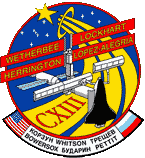 On November 18, 2002 the Space Shuttle Endeavor, Mission STS-113 was launched to the International Space Station. That flight is the last flight flown prior to the tragic flight of Columbia. For the Endeavor flight STS-113, I have made a miniature pot honoring Astronaut John Herrington and the crew of the Endeavor. I wished to honor John and show my pride in him as a fellow Native American (Chickasaw). He represents a modern warrior and carries the hopes and dreams of our Native People. His Tribe and Indian America has honored him in a series of ceremonies and a NASA Conference prior to the launch. John’s mission was to take three space walks to help install a 27,000 pound major truss and other equipment in the space station. On November 18, 2002 the Space Shuttle Endeavor, Mission STS-113 was launched to the International Space Station. That flight is the last flight flown prior to the tragic flight of Columbia. For the Endeavor flight STS-113, I have made a miniature pot honoring Astronaut John Herrington and the crew of the Endeavor. I wished to honor John and show my pride in him as a fellow Native American (Chickasaw). He represents a modern warrior and carries the hopes and dreams of our Native People. His Tribe and Indian America has honored him in a series of ceremonies and a NASA Conference prior to the launch. John’s mission was to take three space walks to help install a 27,000 pound major truss and other equipment in the space station.
A brief history is in order. The American Indian Science and Engineering Society (AISES) came to know John early in his Astronaut career. He became a member of the AISES Board of Directors and a AISES Sequoyah Fellow. He was and is a role model to all our Native youth.
John was the inspiration in 1999 for a ceramic piece I named “Into the 21st Century” showing a line of native dancers greeting a suited astronaut. The metaphor intended is that of “Education” which is a key to our survival strategy for Native People in the 21st Century. The astronaut depicted on the pot is a Native American….and is John Herrington and those who may follow him in the future. John is the first of a new kind of warrior.
When the mission was selected for John, I asked if I could honor him by flying a pottery piece (see below), based on one of the oldest Southwestern forms and includes an image of corn which unites all cultures of the Western Hemisphere. After initiating a proposal that needed John’s consent, and proceeding through the NASA legal process, I received approval from NASA accepting a pottery piece for space flight. Of course I was thrilled. There are also other very important objects that are included in John’s flight kit as well, as reported by an Associated Press (AP) article of this week (Nov. 9th). I treasure John’s friendship and I am pleased to be able to honor John and the crew of STS-113.
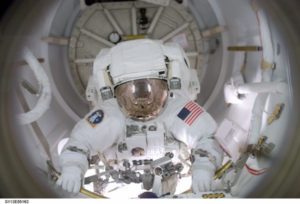
In accordance with NASA policy this article and photo display does not constitute a NASA endorsement of my work or of me as an artist, or reflect as an endorsement by John Herrington as an Astronaut. In order to meet NASA’s policy and legal requirements, such that no commercial value is derived from the flight of an object, objects must be assigned to a repository suitable to NASA. After the flight of this piece was delivered to the permanent collection of the National Museum of American Indian (NMAI), Smithsonian Institution, Washington, D.C.
NMAI will open it’s new Museum on the Capital Mall in an Inaugural opening, September 21, 2004. This piece will be in display describing John’s historic flight, along with other objects carried by John. NMAI, in conjunction with the National Geographic has produced a 371 page Inaugural book “Native Universe”, covering all the Americas. The pot, “a miniature 3 corn Sikyatki pot”, is described in the book’s “Introduction”, along with a photographic image.
And Now, “The Rest of the Story”
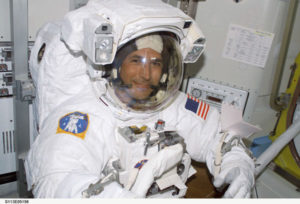 The story starts with my infatuation with technology and the beginnings of the space program; foolhardy perhaps, but it was an interesting ride. In my early years, after graduating in engineering, I worked for the Guidance and Control Division of Litton Systems in advanced research. We conceived new designs and built prototypes of Inertial Guidance and Star Tracker Systems. I became responsible for completing and installing an Inertial Platform (or “IMU”) for the X-15 rocket aircraft (of the Chuck Yeager variety).. The X-15 was the research craft that was the predecessor to the shuttle craft of today’s NASA Shuttle Program. New research and patented IMU’s followed, for military (e.g., F-15) and commercial applications (747’s). I was hooked. The story starts with my infatuation with technology and the beginnings of the space program; foolhardy perhaps, but it was an interesting ride. In my early years, after graduating in engineering, I worked for the Guidance and Control Division of Litton Systems in advanced research. We conceived new designs and built prototypes of Inertial Guidance and Star Tracker Systems. I became responsible for completing and installing an Inertial Platform (or “IMU”) for the X-15 rocket aircraft (of the Chuck Yeager variety).. The X-15 was the research craft that was the predecessor to the shuttle craft of today’s NASA Shuttle Program. New research and patented IMU’s followed, for military (e.g., F-15) and commercial applications (747’s). I was hooked.
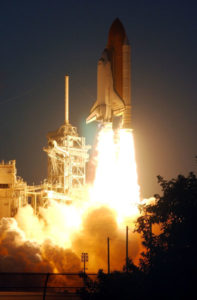 In the following years I changed fields and became Manager of Environmental Programs and Research for the Salt River Project, a power and water utility in Arizona. During this period my pottery career started and I helped co-found the American Indian Science and Engineering Society (AISES) and became the Founding Chairman. At the 1983 National Conference of AISES in Albuquerque I gave a talk before the general assembly on the role of Native Peoples in the future of American society. Two NASA officials were present. Mr. Jurgen Pohly out of Washington D.C. Later he asked that I apply as Mission Specialist in NASA’s Astronaut Program. I did. While I was not selected for that “class”, I did coin the expression “Pots in Space”. In the following years I changed fields and became Manager of Environmental Programs and Research for the Salt River Project, a power and water utility in Arizona. During this period my pottery career started and I helped co-found the American Indian Science and Engineering Society (AISES) and became the Founding Chairman. At the 1983 National Conference of AISES in Albuquerque I gave a talk before the general assembly on the role of Native Peoples in the future of American society. Two NASA officials were present. Mr. Jurgen Pohly out of Washington D.C. Later he asked that I apply as Mission Specialist in NASA’s Astronaut Program. I did. While I was not selected for that “class”, I did coin the expression “Pots in Space”.
In the early years of AISES, about 1985 or so, Phil Lane, Sr. (Lakota) supplied an eagle feather for a Shuttle flight that was carried in the Official Flight Kit (OFK) by the Mission Specialist Astronaut Ellison Onizuka. On return of that flight the feather was given to AISES, where it is prominently displayed at each National Conference. Ellison Onizuka later died in the Challenger loss.
Fast forward to about 1999 or so at AISES. Commander John Herrington (Chickasaw) was elected to the AISES Board of Directors. He was already in the Astronaut Program, but had no assigned mission at that point. We have many conversations regarding his personal involvement in the Space Program.
 In 2001 John Herrington received his assignment as a Mission Specialist for construction on the Space Station in the Shuttle Mission STS-113. Through a request and NASA’s approval, a pot was selected to fly in the OFK of STS-113. A couple of the photos supplied in the attached documentation of the STS-113 pot show an eagle feather in the background. I was given this feather by Phil Lane, Sr. after making a presentation for AISES of the Ely S. Parker award ( one award each year is given to a Native person recognizing their significant contributions to the American Indian community). It so happens that the feather is from the same eagle as the feather flown by Ellison Onizuka. Further, the six eagle feathers attached to the top of the AISES eagle staff represent the original six co-founders of AISES and are from the same eagle. In 2001 John Herrington received his assignment as a Mission Specialist for construction on the Space Station in the Shuttle Mission STS-113. Through a request and NASA’s approval, a pot was selected to fly in the OFK of STS-113. A couple of the photos supplied in the attached documentation of the STS-113 pot show an eagle feather in the background. I was given this feather by Phil Lane, Sr. after making a presentation for AISES of the Ely S. Parker award ( one award each year is given to a Native person recognizing their significant contributions to the American Indian community). It so happens that the feather is from the same eagle as the feather flown by Ellison Onizuka. Further, the six eagle feathers attached to the top of the AISES eagle staff represent the original six co-founders of AISES and are from the same eagle.
 For me, being selected to fly a pot is an honor and one of the high points in my artistic pursuit. I wanted to select a piece of pottery that I felt was representative of ancient America. The Sikyatki form and corn motif selected reflect my Coyote Clan roots from the ancient village of Sikyatki. Ceramics from Sikyatki are some of the most documented in the Smithsonian system, starting with the 17th Annual Report of the Bureau of American Ethnology, 1895-96 on the excavations by Jesse Walter Fewkes. This excavation became the basis of Nampeyo’s Tewa-Hopi revival of Sikyatki designs and shapes. I participated in a research project of the Smithsonian with Dr. Ronald Bishop, Valetta Canouts and Suzanne De Atley. In 1988 we published the paper “The Formation of Ceramic Analytical Groups: Hopi (Sikyatki) Pottery Production and Exchange, AD 1300-1600, Journal of Field Archaeology 15: 317-337. This pottery was produced by members of our Coyote clan. For me, being selected to fly a pot is an honor and one of the high points in my artistic pursuit. I wanted to select a piece of pottery that I felt was representative of ancient America. The Sikyatki form and corn motif selected reflect my Coyote Clan roots from the ancient village of Sikyatki. Ceramics from Sikyatki are some of the most documented in the Smithsonian system, starting with the 17th Annual Report of the Bureau of American Ethnology, 1895-96 on the excavations by Jesse Walter Fewkes. This excavation became the basis of Nampeyo’s Tewa-Hopi revival of Sikyatki designs and shapes. I participated in a research project of the Smithsonian with Dr. Ronald Bishop, Valetta Canouts and Suzanne De Atley. In 1988 we published the paper “The Formation of Ceramic Analytical Groups: Hopi (Sikyatki) Pottery Production and Exchange, AD 1300-1600, Journal of Field Archaeology 15: 317-337. This pottery was produced by members of our Coyote clan.
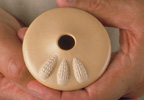 It is my suspicion based on both family oral history and analysis that we might be of a Keres speaking origin. Sikyatki pottery has been found in quantity at Pottery Mound (New Mexico) and Hawikuh (Zuni). The designs in all three areas are the basis for my new “Polychrome Series”. Further the unique designs appear distinctly (as compared to the Katsina group) in kiva murals at Awatovi (Hopi) in contrast to the Hopi Katsina group content in the murals. The Sikyatki designs can also be seen distinctly in the Pottery Mound murals. Much is being learned today about the origins of the Katsina group. It is my suspicion based on both family oral history and analysis that we might be of a Keres speaking origin. Sikyatki pottery has been found in quantity at Pottery Mound (New Mexico) and Hawikuh (Zuni). The designs in all three areas are the basis for my new “Polychrome Series”. Further the unique designs appear distinctly (as compared to the Katsina group) in kiva murals at Awatovi (Hopi) in contrast to the Hopi Katsina group content in the murals. The Sikyatki designs can also be seen distinctly in the Pottery Mound murals. Much is being learned today about the origins of the Katsina group.
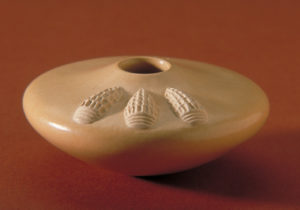 Based upon ancient corn grinding songs my aunt (Polingaysi Qöyawayma, aka Elizabeth Q. White, my mentor and pottery teacher) created the reprosse’ formed corn motif used on the STS-113 pot. Both Elizabeth and I were stunned in 1976 when an exhibit and book on “Ancient Ecuador: Culture, Clay & Creativity 3000-300B.C., organized by the Field Museum of Natural History, displayed pottery nearly identical in form and corn motif to the pottery Elizabeth and I were producing. Our pottery is considered to be new and contemporary pottery. Had somehow the old corn grinding songs and genetic memory been recalled by Elizabeth? The exhibited ceramics had come from Valdivia, Ecuador at around 3000 B.C. As NMAI personnel may know Smithsonian’s Betty Meggers has advanced the hypothesis of Japanese “Trans-Pacific” contact occurred Based upon ancient corn grinding songs my aunt (Polingaysi Qöyawayma, aka Elizabeth Q. White, my mentor and pottery teacher) created the reprosse’ formed corn motif used on the STS-113 pot. Both Elizabeth and I were stunned in 1976 when an exhibit and book on “Ancient Ecuador: Culture, Clay & Creativity 3000-300B.C., organized by the Field Museum of Natural History, displayed pottery nearly identical in form and corn motif to the pottery Elizabeth and I were producing. Our pottery is considered to be new and contemporary pottery. Had somehow the old corn grinding songs and genetic memory been recalled by Elizabeth? The exhibited ceramics had come from Valdivia, Ecuador at around 3000 B.C. As NMAI personnel may know Smithsonian’s Betty Meggers has advanced the hypothesis of Japanese “Trans-Pacific” contact occurred  at Valdivia during the Jomon period in Japan. The ceramics of that period from Valdivia and Japan are nearly identical in decoration motifs (not corn). I visited a display of the Valdivia pottery, with the corn motif, at the Smithsonian some years ago. On page 30 of the May/June 2003 issue of Archeology”, the Meggers hypothesis is again presented. Even more recently the book “The Zuni Enigma”, 2000, by Nancy Yaw Davis presents the hypothesis that there was further significant Japanese contact with the Zuni, specifically the Hawikuh site. Some consultation with Betty Meggers was involved in this book. So maybe lighting strikes twice, since the Sikyatki designs reflect the Zuni Hawikuh designs. Sikyatki peoples are often referred to in the archaeology literature as the “Flower People”. That’s interesting because in the Davis hypothesis the Zuni flower designs were nearly identical to the Japan flower designs of the period. at Valdivia during the Jomon period in Japan. The ceramics of that period from Valdivia and Japan are nearly identical in decoration motifs (not corn). I visited a display of the Valdivia pottery, with the corn motif, at the Smithsonian some years ago. On page 30 of the May/June 2003 issue of Archeology”, the Meggers hypothesis is again presented. Even more recently the book “The Zuni Enigma”, 2000, by Nancy Yaw Davis presents the hypothesis that there was further significant Japanese contact with the Zuni, specifically the Hawikuh site. Some consultation with Betty Meggers was involved in this book. So maybe lighting strikes twice, since the Sikyatki designs reflect the Zuni Hawikuh designs. Sikyatki peoples are often referred to in the archaeology literature as the “Flower People”. That’s interesting because in the Davis hypothesis the Zuni flower designs were nearly identical to the Japan flower designs of the period.
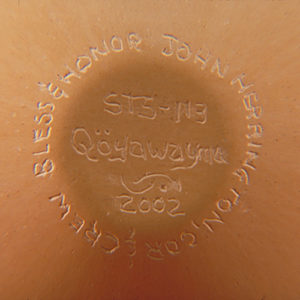 The overall point is that I have chosen both a form and corn motif from some of the most ancient in the Americas as a tribute to John Herrington, the crew, and Native peoples to fly in space. And, it flew with the first Native American to fly in space. The “ancient indeed meets the modern” (and, that was also foretold as the destiny or “duty” of Coyote Clan descendants). So that was the basis of my pottery submittal to NASA. One thing for sure is the “pot(s) in space” did occur. It is the fastest pot of ancient Native American concept, at a speed of 17,085 MPH, altitude of 249 miles and after traveling some 5.67 million miles. It spent some 13 days, 18 hours and 47 minutes in space, traveling to the International Space Station aboard the Endeavor. The Endeavor was launched November 23, 2002 at 6:50 P.M. CST and landed December 7, 2002 at 1:37 P.M. CST. A “Certificate of Flight” for the STS-113 pot (or “Space Pot” as the NMAI staff has nick named it, see below) was delivered to NMAI confirming the above details. The overall point is that I have chosen both a form and corn motif from some of the most ancient in the Americas as a tribute to John Herrington, the crew, and Native peoples to fly in space. And, it flew with the first Native American to fly in space. The “ancient indeed meets the modern” (and, that was also foretold as the destiny or “duty” of Coyote Clan descendants). So that was the basis of my pottery submittal to NASA. One thing for sure is the “pot(s) in space” did occur. It is the fastest pot of ancient Native American concept, at a speed of 17,085 MPH, altitude of 249 miles and after traveling some 5.67 million miles. It spent some 13 days, 18 hours and 47 minutes in space, traveling to the International Space Station aboard the Endeavor. The Endeavor was launched November 23, 2002 at 6:50 P.M. CST and landed December 7, 2002 at 1:37 P.M. CST. A “Certificate of Flight” for the STS-113 pot (or “Space Pot” as the NMAI staff has nick named it, see below) was delivered to NMAI confirming the above details.
In accordance with NASA regulations C.F.R.(Code of Federal Regulations) Subpart 1214.6, this page is NOT to be reproduced for distribution or attached to any other Internet link or webpage. Further questions should be directed to:
Doug Peterson
Public Affairs Officer
NASA Johnson Space Center
Houston, TX
(281) 244-8406 |
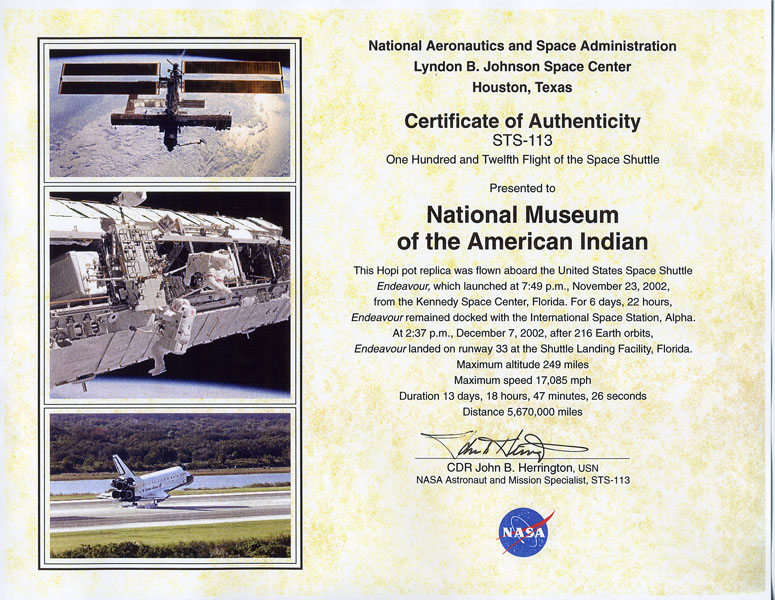



 On November 18, 2002 the Space Shuttle Endeavor, Mission STS-113 was launched to the International Space Station. That flight is the last flight flown prior to the tragic flight of Columbia. For the Endeavor flight STS-113, I have made a miniature pot honoring Astronaut John Herrington and the crew of the Endeavor. I wished to honor John and show my pride in him as a fellow Native American (Chickasaw). He represents a modern warrior and carries the hopes and dreams of our Native People. His Tribe and Indian America has honored him in a series of ceremonies and a NASA Conference prior to the launch. John’s mission was to take three space walks to help install a 27,000 pound major truss and other equipment in the space station.
On November 18, 2002 the Space Shuttle Endeavor, Mission STS-113 was launched to the International Space Station. That flight is the last flight flown prior to the tragic flight of Columbia. For the Endeavor flight STS-113, I have made a miniature pot honoring Astronaut John Herrington and the crew of the Endeavor. I wished to honor John and show my pride in him as a fellow Native American (Chickasaw). He represents a modern warrior and carries the hopes and dreams of our Native People. His Tribe and Indian America has honored him in a series of ceremonies and a NASA Conference prior to the launch. John’s mission was to take three space walks to help install a 27,000 pound major truss and other equipment in the space station.
 The story starts with my infatuation with technology and the beginnings of the space program; foolhardy perhaps, but it was an interesting ride. In my early years, after graduating in engineering, I worked for the Guidance and Control Division of Litton Systems in advanced research. We conceived new designs and built prototypes of Inertial Guidance and Star Tracker Systems. I became responsible for completing and installing an Inertial Platform (or “IMU”) for the X-15 rocket aircraft (of the Chuck Yeager variety).. The X-15 was the research craft that was the predecessor to the shuttle craft of today’s NASA Shuttle Program. New research and patented IMU’s followed, for military (e.g., F-15) and commercial applications (747’s). I was hooked.
The story starts with my infatuation with technology and the beginnings of the space program; foolhardy perhaps, but it was an interesting ride. In my early years, after graduating in engineering, I worked for the Guidance and Control Division of Litton Systems in advanced research. We conceived new designs and built prototypes of Inertial Guidance and Star Tracker Systems. I became responsible for completing and installing an Inertial Platform (or “IMU”) for the X-15 rocket aircraft (of the Chuck Yeager variety).. The X-15 was the research craft that was the predecessor to the shuttle craft of today’s NASA Shuttle Program. New research and patented IMU’s followed, for military (e.g., F-15) and commercial applications (747’s). I was hooked. In the following years I changed fields and became Manager of Environmental Programs and Research for the Salt River Project, a power and water utility in Arizona. During this period my pottery career started and I helped co-found the American Indian Science and Engineering Society (AISES) and became the Founding Chairman. At the 1983 National Conference of AISES in Albuquerque I gave a talk before the general assembly on the role of Native Peoples in the future of American society. Two NASA officials were present. Mr. Jurgen Pohly out of Washington D.C. Later he asked that I apply as Mission Specialist in NASA’s Astronaut Program. I did. While I was not selected for that “class”, I did coin the expression “Pots in Space”.
In the following years I changed fields and became Manager of Environmental Programs and Research for the Salt River Project, a power and water utility in Arizona. During this period my pottery career started and I helped co-found the American Indian Science and Engineering Society (AISES) and became the Founding Chairman. At the 1983 National Conference of AISES in Albuquerque I gave a talk before the general assembly on the role of Native Peoples in the future of American society. Two NASA officials were present. Mr. Jurgen Pohly out of Washington D.C. Later he asked that I apply as Mission Specialist in NASA’s Astronaut Program. I did. While I was not selected for that “class”, I did coin the expression “Pots in Space”. In 2001 John Herrington received his assignment as a Mission Specialist for construction on the Space Station in the Shuttle Mission STS-113. Through a request and NASA’s approval, a pot was selected to fly in the OFK of STS-113. A couple of the photos supplied in the attached documentation of the STS-113 pot show an eagle feather in the background. I was given this feather by Phil Lane, Sr. after making a presentation for AISES of the Ely S. Parker award ( one award each year is given to a Native person recognizing their significant contributions to the American Indian community). It so happens that the feather is from the same eagle as the feather flown by Ellison Onizuka. Further, the six eagle feathers attached to the top of the AISES eagle staff represent the original six co-founders of AISES and are from the same eagle.
In 2001 John Herrington received his assignment as a Mission Specialist for construction on the Space Station in the Shuttle Mission STS-113. Through a request and NASA’s approval, a pot was selected to fly in the OFK of STS-113. A couple of the photos supplied in the attached documentation of the STS-113 pot show an eagle feather in the background. I was given this feather by Phil Lane, Sr. after making a presentation for AISES of the Ely S. Parker award ( one award each year is given to a Native person recognizing their significant contributions to the American Indian community). It so happens that the feather is from the same eagle as the feather flown by Ellison Onizuka. Further, the six eagle feathers attached to the top of the AISES eagle staff represent the original six co-founders of AISES and are from the same eagle. For me, being selected to fly a pot is an honor and one of the high points in my artistic pursuit. I wanted to select a piece of pottery that I felt was representative of ancient America. The Sikyatki form and corn motif selected reflect my Coyote Clan roots from the ancient village of Sikyatki. Ceramics from Sikyatki are some of the most documented in the Smithsonian system, starting with the 17th Annual Report of the Bureau of American Ethnology, 1895-96 on the excavations by Jesse Walter Fewkes. This excavation became the basis of Nampeyo’s Tewa-Hopi revival of Sikyatki designs and shapes. I participated in a research project of the Smithsonian with Dr. Ronald Bishop, Valetta Canouts and Suzanne De Atley. In 1988 we published the paper “The Formation of Ceramic Analytical Groups: Hopi (Sikyatki) Pottery Production and Exchange, AD 1300-1600, Journal of Field Archaeology 15: 317-337. This pottery was produced by members of our Coyote clan.
For me, being selected to fly a pot is an honor and one of the high points in my artistic pursuit. I wanted to select a piece of pottery that I felt was representative of ancient America. The Sikyatki form and corn motif selected reflect my Coyote Clan roots from the ancient village of Sikyatki. Ceramics from Sikyatki are some of the most documented in the Smithsonian system, starting with the 17th Annual Report of the Bureau of American Ethnology, 1895-96 on the excavations by Jesse Walter Fewkes. This excavation became the basis of Nampeyo’s Tewa-Hopi revival of Sikyatki designs and shapes. I participated in a research project of the Smithsonian with Dr. Ronald Bishop, Valetta Canouts and Suzanne De Atley. In 1988 we published the paper “The Formation of Ceramic Analytical Groups: Hopi (Sikyatki) Pottery Production and Exchange, AD 1300-1600, Journal of Field Archaeology 15: 317-337. This pottery was produced by members of our Coyote clan. Based upon ancient corn grinding songs my aunt (Polingaysi Qöyawayma, aka Elizabeth Q. White, my mentor and pottery teacher) created the reprosse’ formed corn motif used on the STS-113 pot. Both Elizabeth and I were stunned in 1976 when an exhibit and book on “Ancient Ecuador: Culture, Clay & Creativity 3000-300B.C., organized by the Field Museum of Natural History, displayed pottery nearly identical in form and corn motif to the pottery Elizabeth and I were producing. Our pottery is considered to be new and contemporary pottery. Had somehow the old corn grinding songs and genetic memory been recalled by Elizabeth? The exhibited ceramics had come from Valdivia, Ecuador at around 3000 B.C. As NMAI personnel may know Smithsonian’s Betty Meggers has advanced the hypothesis of Japanese “Trans-Pacific” contact occurred
Based upon ancient corn grinding songs my aunt (Polingaysi Qöyawayma, aka Elizabeth Q. White, my mentor and pottery teacher) created the reprosse’ formed corn motif used on the STS-113 pot. Both Elizabeth and I were stunned in 1976 when an exhibit and book on “Ancient Ecuador: Culture, Clay & Creativity 3000-300B.C., organized by the Field Museum of Natural History, displayed pottery nearly identical in form and corn motif to the pottery Elizabeth and I were producing. Our pottery is considered to be new and contemporary pottery. Had somehow the old corn grinding songs and genetic memory been recalled by Elizabeth? The exhibited ceramics had come from Valdivia, Ecuador at around 3000 B.C. As NMAI personnel may know Smithsonian’s Betty Meggers has advanced the hypothesis of Japanese “Trans-Pacific” contact occurred  at Valdivia during the Jomon period in Japan. The ceramics of that period from Valdivia and Japan are nearly identical in decoration motifs (not corn). I visited a display of the Valdivia pottery, with the corn motif, at the Smithsonian some years ago. On page 30 of the May/June 2003 issue of Archeology”, the Meggers hypothesis is again presented. Even more recently the book “The Zuni Enigma”, 2000, by Nancy Yaw Davis presents the hypothesis that there was further significant Japanese contact with the Zuni, specifically the Hawikuh site. Some consultation with Betty Meggers was involved in this book. So maybe lighting strikes twice, since the Sikyatki designs reflect the Zuni Hawikuh designs. Sikyatki peoples are often referred to in the archaeology literature as the “Flower People”. That’s interesting because in the Davis hypothesis the Zuni flower designs were nearly identical to the Japan flower designs of the period.
at Valdivia during the Jomon period in Japan. The ceramics of that period from Valdivia and Japan are nearly identical in decoration motifs (not corn). I visited a display of the Valdivia pottery, with the corn motif, at the Smithsonian some years ago. On page 30 of the May/June 2003 issue of Archeology”, the Meggers hypothesis is again presented. Even more recently the book “The Zuni Enigma”, 2000, by Nancy Yaw Davis presents the hypothesis that there was further significant Japanese contact with the Zuni, specifically the Hawikuh site. Some consultation with Betty Meggers was involved in this book. So maybe lighting strikes twice, since the Sikyatki designs reflect the Zuni Hawikuh designs. Sikyatki peoples are often referred to in the archaeology literature as the “Flower People”. That’s interesting because in the Davis hypothesis the Zuni flower designs were nearly identical to the Japan flower designs of the period. The overall point is that I have chosen both a form and corn motif from some of the most ancient in the Americas as a tribute to John Herrington, the crew, and Native peoples to fly in space. And, it flew with the first Native American to fly in space. The “ancient indeed meets the modern” (and, that was also foretold as the destiny or “duty” of Coyote Clan descendants). So that was the basis of my pottery submittal to NASA. One thing for sure is the “pot(s) in space” did occur. It is the fastest pot of ancient Native American concept, at a speed of 17,085 MPH, altitude of 249 miles and after traveling some 5.67 million miles. It spent some 13 days, 18 hours and 47 minutes in space, traveling to the International Space Station aboard the Endeavor. The Endeavor was launched November 23, 2002 at 6:50 P.M. CST and landed December 7, 2002 at 1:37 P.M. CST. A “Certificate of Flight” for the STS-113 pot (or “Space Pot” as the NMAI staff has nick named it, see below) was delivered to NMAI confirming the above details.
The overall point is that I have chosen both a form and corn motif from some of the most ancient in the Americas as a tribute to John Herrington, the crew, and Native peoples to fly in space. And, it flew with the first Native American to fly in space. The “ancient indeed meets the modern” (and, that was also foretold as the destiny or “duty” of Coyote Clan descendants). So that was the basis of my pottery submittal to NASA. One thing for sure is the “pot(s) in space” did occur. It is the fastest pot of ancient Native American concept, at a speed of 17,085 MPH, altitude of 249 miles and after traveling some 5.67 million miles. It spent some 13 days, 18 hours and 47 minutes in space, traveling to the International Space Station aboard the Endeavor. The Endeavor was launched November 23, 2002 at 6:50 P.M. CST and landed December 7, 2002 at 1:37 P.M. CST. A “Certificate of Flight” for the STS-113 pot (or “Space Pot” as the NMAI staff has nick named it, see below) was delivered to NMAI confirming the above details.